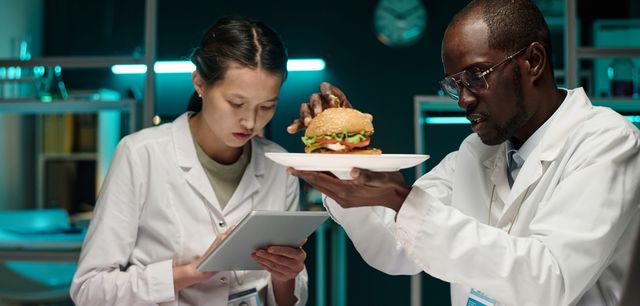02 May 2024
The big promise behind in vitro meat is that you will be able to carry on tucking into juicy burgers without causing the death of a cow in the process. More and more start-ups are playing around with meat that is lab-grown from stem cells. In vitro meat is currently only available in the US and Singapore. It was a German company that submitted the EU’s first application for approval of a sausage made from cell cultures in the autumn of 2023. But will eating lab-grown meat also help combat climate change?
Leonardo DiCaprio’s involvement with art isn’t limited to the silver screen. It includes his personal collection, which features works by Pablo Picasso, for example – and also his investments in two start-ups dedicated to in vitro meat: Mosa Meat unveiled the first cell-cultured burger in 2013, and Aleph Farms followed with the first steak from a bioreactor in 2018. “Changing our diet is one of the keys to fighting the climate crisis,” said the environmental activist and Oscar winner. And the global appetite for animal products has played a significant role in this same crisis.
With all it involves, from milk to wool to meat, livestock farming accounts for 14.5 percent of all man-made greenhouse gas emissions, according to the Food and Agriculture Organization of the United Nations (FAO). This situation could get even worse in the future, because as the global population grows and prosperity increases in industrialised and emerging countries, so, too, does the appetite for meat. Just in the years from 1965 to 2020, global meat production more than quadrupled. By 2050, the FAO anticipates a further increase of around 35 percent.
Bill Gates, for example, is also convinced that this global appetite could be satisfied, at least in part, with meat from bioreactors. The Microsoft founder has called on the rich countries of the world to switch completely to synthetic beef to reduce greenhouse gas emissions.
A water-saving, but energy-hungry process
To date, lab-grown meat has only been cultivated on a small scale. So, any projections concerning its benefits to the climate are preliminary at best. However, researchers are already in agreement about one thing: Compared to conventional agriculture, the production of cell-cultured meat requires less water and land, and soil and water are also less vulnerable to pollution by pesticides, antibiotics and fertilisers. But it is already clear that the bioreactors in which the meat is grown need a lot of energy. “If we cover this from renewable sources from the outset, we’ll be able to keep the technology’s carbon footprint as small as possible,” says Petra Kluger, a researcher into in vitro meat at Reutlingen University.
According to a study by the think tank CE Delft, the production of one kilogramme of cultured meat using fossil fuels generates 13.6 kilogrammes of CO2 – the same as beef, which is particularly harmful to the climate. If, on the other hand, electricity from wind or solar energy were to be used, the carbon footprint would shrink to 2.5 kilogrammes. This is about half of the CO2 value of chicken or pork from conventional animal husbandry.
© Adobe StockLaboratory testing: what about the quality of in-vitro meat?
© Adobe StockA biotechnology researcher is working with cell cultures on the steak of tomorrow.
How meat is produced in a bioreactor
Whether they are growing chicken, pork or beef, to produce in vitro meat researchers and food start-ups generally proceed in a similar way. First, a tiny piece of tissue is taken from living animals. From this, stem cells are obtained, which are then multiplied in a bioreactor using a nutrient medium. Using a support structure made of chitin or collagen, for example, the cells grow together to form a larger mass, which can then be used to form burger meat, for example, or to fill ravioli.
Whereas the first stem cell burger produced a good ten years ago consisted exclusively of muscle tissue and was too bland and dry for the test consumers, adipose tissue can now also be cultivated in the laboratory. “And this will play a decisive role in making the meat taste right,” explains biologist Petra Kluger.
Meat from bioreactors might even be healthier than its natural counterpart: Pathogens and parasites can’t spread under laboratory conditions. And by adding vitamins, for example, the cultured meat can be designed precisely to meet the needs of different target groups: Lots of folic acid for pregnant women, lots of protein for athletes, and meat rich in vitamin D and calcium, which is also easier to chew than conventional roast beef, for senior citizens in particular. “We can let the imagination run riot here, in fact,” says Petra Kluger. Her research group, along with the University of Hohenheim, has experimented with the addition of vitamin E, for example, which many people run short of in the winter.
Alternative culture media in demand
However, the cell culture meat which emerges from the bioreactor is not yet completely free of animal suffering. This is because the nutrient solution for the growth of the cells is usually obtained from the blood of unborn calves. “Of course, this isn’t ethically justifiable and would simply be too expensive for large-scale production,” biologist Petra Kluger explains. Start-ups and research institutes are therefore working on cheaper and animal-free alternatives, for example from fungi, yeast or algae. In a research project, Petra Kluger and her team have also investigated whether waste from regional agriculture might also be used as the basis for a nutrient solution. “The results are really encouraging,” says the biologist.
Growing in vitro steak remains complicated
Kluger thinks it unlikely that steaks good enough to be mistaken for the real thing will be cultivated in the laboratory alongside minced meat and sausage meat in the foreseeable future. It is true that muscle cells can be allowed to mature longer to form muscle fibres such as those found in “real” meat. However, this prolongs the process and makes production more expensive, and no conclusive technological solution has yet been found. “As an alternative, you can combine the cell meat with vegetable proteins to get something quite close to the texture of the meat,” says Petra Kluger. This will further reduce the product’s carbon footprint and also lower the costs, which are currently significantly higher than those incurred in meat production from conventional animal husbandry. Heidelberg-based company The Cultivated B., which submitted the EU’s first application for approval for an in vitro sausage in September 2023, has also turned to a blend using plant proteins in exactly this way.
The long road to mass production
However, it is still likely to be a few years before the start-up’s hybrid hotdog hits the European market. This is because, as “novel food”, the cell-cultured sausage must undergo a regulatory process that is as strict as it is lengthy to reliably rule out any health consequences for consumers. At the same time, The Cultivated B. is working with other companies on processes to produce cell culture meat on an industrial scale. “In terms of biotechnology, this is still the greatest challenge we face, and it will need to be overcome if in vitro meat is ever going to be offered for sale at a reasonable price,” explains Petra Kluger.
In the first instance, lab-grown meat will only have a small market share, and it won’t supplant agriculture in 20 years’ time either; instead, it will complement it in the long term, Petra Kluger says with conviction. Unlike in the US, Israel or the Netherlands, however, the massive potential of this technology has so far not been appreciated in this country. Subsidies are too few and far between, the expert explains: “We’re going to have to up the stakes and move faster to ensure that we don’t miss out on this technology of tomorrow.”





